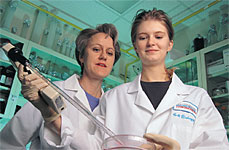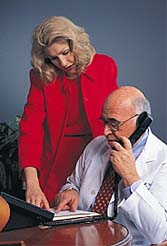 roductive
research has long been the driving force for developing superb multidisciplinary
cancer care at M. D. Anderson. The institution’s ability to translate
laboratory discoveries to more effectively treat patients is unparalleled. roductive
research has long been the driving force for developing superb multidisciplinary
cancer care at M. D. Anderson. The institution’s ability to translate
laboratory discoveries to more effectively treat patients is unparalleled.
 Research
programs are conducted in 484 laboratories, which have 817 support
areas and 686 office support rooms located throughout the main M.
D. Anderson complex as well as at satellite sites, such as the Smith
Research Building. Research
programs are conducted in 484 laboratories, which have 817 support
areas and 686 office support rooms located throughout the main M.
D. Anderson complex as well as at satellite sites, such as the Smith
Research Building.
 Many
research projects depend on animals — 99 percent mice and rats
— to study cancer initiation and progression, and then to analyze
newer drugs, biologic agents, radiation techniques and surgical
procedures in the animals before applying to patients. The Department
of Veterinary Medicine and Surgery oversees breeding and use of
approximately 34,000 research animals involved in 459 specific research
protocols. Many
research projects depend on animals — 99 percent mice and rats
— to study cancer initiation and progression, and then to analyze
newer drugs, biologic agents, radiation techniques and surgical
procedures in the animals before applying to patients. The Department
of Veterinary Medicine and Surgery oversees breeding and use of
approximately 34,000 research animals involved in 459 specific research
protocols.
 Diverse
research projects also are conducted at two units of M. D. Anderson’s
Science Park in Bastrop County near Austin. All of the nearly 12,000
animals bred and used in the Department of Carcinogenesis at the
Science Park-Research Division in Smithville are rodents, who are
helping scientists there better understand how to prevent many cancers. Diverse
research projects also are conducted at two units of M. D. Anderson’s
Science Park in Bastrop County near Austin. All of the nearly 12,000
animals bred and used in the Department of Carcinogenesis at the
Science Park-Research Division in Smithville are rodents, who are
helping scientists there better understand how to prevent many cancers.
 Veterinarians and support staff at the Science Park’s Department
of Veterinary Sciences (DVS) near Bastrop coordinate production
and use of animals at the Research Division as well as more than
4,000 animals raised and monitored on the 375-acre rural site operated
by the DVS. This group includes mice, rats, rabbits, goats, sheep,
rhesus monkeys and chimpanzees.
Veterinarians and support staff at the Science Park’s Department
of Veterinary Sciences (DVS) near Bastrop coordinate production
and use of animals at the Research Division as well as more than
4,000 animals raised and monitored on the 375-acre rural site operated
by the DVS. This group includes mice, rats, rabbits, goats, sheep,
rhesus monkeys and chimpanzees.
|

|
Dr. Janet E. Price
(left), associate professor of cancer biology, shows graduate
student Emily Van Laar how best to prepare cultures of breast
cancer cells. Dr. Price’s laboratory in M. D. Anderson’s
Smith Research Building focuses on understanding why some
breast cancer cells spread to other parts of the body.
|
|

